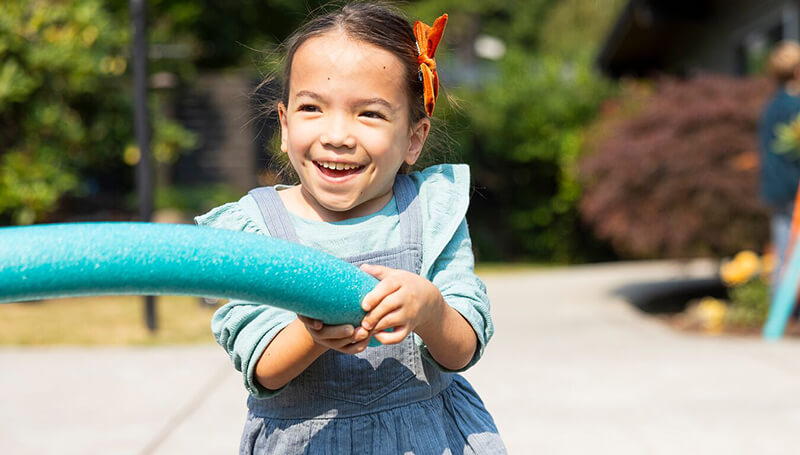It’s a Messy Topic, but Let’s Talk About Poop
3.17.2023 | Seattle Children's Press Team
There are a lot of ways to describe it: soft, hard, brown, green, runny and stinky. It’s a messy topic often discussed behind closed doors, but today, we’re breaking down what you need to know about poop – from its color, consistency and frequency, to what to do when a child is backed up.
According to Dr. Mollie Grow, a pediatrician at Seattle Children’s and the University of Washington, it can be challenging for some families to be open about the body’s natural process of elimination. In other words, it can be hard to talk about poop. There’s often embarrassment talking about the subject when there shouldn’t be.
“As pediatricians, we get really comfortable talking about poop,” said Grow. “We try to normalize the conversation with patients and families.”
Breaking It Down
According to Grow, normal, healthy poop can range in color. This is especially true for babies, when parents are more aware of poop changes day to day. Grow says to think about the colors of fall when evaluating if there is cause for concern.
“Green, brown and yellow can all be normal,” said Grow. “But if the colors are more like Mickey Mouse – black, white and red – then you should call your child’s doctor. These colors are abnormal and can indicate something might be wrong.”
If a child’s poop is black it can be a sign of internal bleeding. If there is red, or blood, in the stool, a child may have a cut around their bottom or in their intestine. White poop occurs when there is a lack of bile and may indicate an underlying problem, but according to Grow, it is very rare.
 “It’s a good idea to check in with your child’s doctor if you see any of these colors,” said Grow.
“It’s a good idea to check in with your child’s doctor if you see any of these colors,” said Grow.
It’s also important to note that diet can play a role in the color of child’s poop. For example, eating a lot of iron could cause poop to look darker and eating beets could make a child’s poop look red.
When it comes to frequency, Grow says children should poop every one to two days and the consistency should be soft and formed, much like soft serve ice cream. If a child’s poop is hard, dry, resembles pellets, or if a child has to strain, they may be constipated.
According to Grow, constipation is one of the most common complaints she sees during clinic visits, and a quarter of referrals to gastroenterologists are related to constipation.
“One of the most common symptoms is abdominal pain,” said Grow. “If a child has tummy pain, the first question you should ask is, ‘When was the last time you pooped?’”
Backed Up
According to Grow, there are a number of risk factors for constipation.
“Low intake of fiber and fluids can cause constipation,” said Grow. “It’s important to make sure kids are drinking water between meals and eating enough whole fruits and vegetables. Pitted fruits, like apricots or plums, and also pears tend to be really good sources of fiber. Don’t overdo it on bananas, which can be constipating. Also, avoid too much dairy and offer primarily whole grains. Many kids suffer from constipation due to high intake of fast foods and processed foods, which tend to have very little fiber. Admittedly, it is a challenge for families who are always on the go. Looking for ways to add whole foods and food cooked at home is helpful.”
Grow also recommends regular exercise to keep constipation at bay.
“Our digestive system works better when we’re active,” said Grow. “Preschoolers need lots of active play time. They should get 2 hours each day. Older children should get at least 60 minutes of daily activity. A great way to stay active is by encouraging outdoor time and physical play. A sedentary lifestyle can increase your risk for constipation.”
Seeking Intervention
If a child is constipated, it’s key to seek early intervention. According to Grow, the biggest concern in not treating the problem is that constipation can lead to a child’s inability to feel when it’s time to go to the bathroom. If a child is constipated and has a large collection of stool in their rectum, a child can leak poop, called encopresis. If a child holds their poop, they can also lose tone in their rectum.
“It’s a really big problem,” said Grow. “Kids can’t control the leaking poop and it can be a big source of embarrassment. What we’re trying to avoid is the retention of poop.”
Another sign a child could be constipated is if they have a sudden increase is bedwetting. When a child holds in their poop, the collection of poop can push on their bladder. With early intervention, the issue can be managed.
“The combination of what we can do from a feeding standpoint and activity standpoint, work hand in hand,” said Grow. “Constipation is a common cause of distress in families. The earlier we can intervene, the better. Often, diet changes can help manage it, but if it doesn’t, there are good medicines that can help.”
Talking about poop, just like going to the bathroom, doesn’t need to be a straining experience. Talk to children about poop and make the experience enjoyable.
“We want kids to not have a fear of poop, especially when they are learning to toilet train,” said Grow.
Grow also recommends to talk to children as they get older about their poop. As children get older, parents will be less in tune with their toilet habits, and so being able to talk about poop will help parents identify if something needs to be addressed with their doctor.
So the next time a child says, “My tummy hurts,” it’s helpful to ask, “When was the last time you went poop?”
